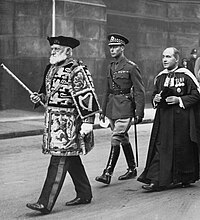Portal:Heraldry
Welcome to the Heraldry and Vexillology Portal!


Heraldry encompasses all of the duties of a herald, including the science and art of designing, displaying, describing and recording coats of arms and badges, as well as the formal ceremonies and laws that regulate the use and inheritance of arms. The origins of heraldry lie in the medieval need to distinguish participants in battles or jousts, whose faces were hidden by steel helmets.
Vexillology (from the Latin vexillum, a flag or banner) is the scholarly study of flags, including the creation and development of a body of knowledge about flags of all types, their forms and functions, and of scientific theories and principles based on that knowledge. Flags were originally used to assist military coordination on the battlefield, and have evolved into a general tool for signalling and identification, particularly identification of countries.
Selected article

The tradition and practice of heraldry in Poland dates from the 13th century. Although influenced by French and German heraldic practice, differs in a number of respects. One of the most striking is that a coat of arms does not belong to a single family. Many, sometimes hundreds of unrelated families may use a single coat of arms. Each coat of arms also has its own name. One side-effect of this unique arrangement was that it became customary to refer to members of the nobility (Polish: Szlachta) by both their family name and the name of their coat of arms. (more...)
Selected biography

Johannes Baptista Rietstap (12 May 1828–24 December 1891) was a Dutch heraldist and genealogist, who is often considered to be the father of modern heraldry in the Netherlands. Rietstap was proficient in English, French, German, Spanish and Latin in addition to his mother tongue, and from the 1850s to the 1870s published a large number of translations of both fiction and non-fiction works. He also worked as a stenographer for the Staten-Generaal for 37 years, eventually rising to the position of First Stenographer. He is most well-known however for his publication of the Armorial Général. This monumental work contains the blazons of the coats of arms of more than 130,000 European families, and is still one of the most complete works of its kind. (more...)
Selected flag

The National Flag of India was adopted in its present form during an ad hoc meeting of the Constituent Assembly held on the 22 July 1947, twenty-four days before India's independence from the British on 15 August 1947. It has served as the national flag of the Dominion of India between 15 August 1947 and 26 January 1950 and that of the Republic of India thereafter.
Designed by Pingali Venkayya, the flag is a horizontal tricolour of "deep saffron" at the top, white in the middle, and green at the bottom. In the centre, there is a navy blue wheel with twenty-four spokes, known as the Ashoka Chakra, taken from the Lion Capital of Asoka erected atop Ashoka pillar at Sarnath. The diameter of this Chakra is three-fourths of the height of the white strip. The ratio of the width of the flag to its length is 2:3. The official flag specifications require that the flag be made only of "khadi," a special type of hand-spun cloth made popular by Mahatma Gandhi. The display and use of the flag are strictly enforced by the Indian Flag Code. (more...)
Selected picture

Sir Francis Grant, Lord Lyon King of Arms, HRH The Duke of York, and Rev. Charles Warr proceeding to the Armistice Service at St. Giles' Cathedral, Edinburgh, in 1933.
Did you know...
- ...that Johan Teterisa was sentenced to life in prison for waving the banned secessionist flag (pictured) of the so-called Republic of the South Moluccas in front of Indonesian President Susilo Bambang Yudhoyono during a nonviolent protest?
- ...that British politician Jock Stallard was expelled from the Labour Party in the 1950s for flying the red flag from St Pancras town hall, but later served as a Labour MP and life peer?
- ...that the Seal of Oregon includes a British man-of-war departing and an American steamer arriving?
- ...that the flags hoisted by the Finnish icebreaker Tarmo on 3 March 1918 included a large white tablecloth?
- ...that Kasim Reed, a 2009 Atlanta mayoral candidate, is known for keeping the battle emblem of the Confederate States of America from being considered for inclusion on the Georgia State Flag?
Related portals
Major topics and navigation
|
|
|
Heraldry Web resources
Authorities
- Belgium - The Council of Nobility, Flemish Heraldic Council and Council of Heraldry and Vexillology of the French Community
- Canada - Canadian Heraldic Authority and see also Public Register of Arms, Flags and Badges
- England, Wales, and Northern Ireland - The College of Arms
- Ireland - The Office of the Chief Herald of Ireland
- Netherlands - High Council of Nobility
- Portugal - Instituto da Nobreza Portuguesa
- Scotland - The Court of the Lord Lyon
- South Africa - South African Bureau of Heraldry
- Sweden - National Board of Heraldry, The National Archive
- United States Army - The United States Army Institute of Heraldry
Societies
- Greek Heraldry Society
- The Academy of Heraldic Science Czech republic
- The American College of Heraldry
- The American Heraldry Society
- The Augustan Society
- The Australian Heraldry Society Inc.
- Bulgarian Heraldry and Vexillology Society
- The Center for Research of Orthodox Monarchism
- Cambridge University Heraldic and Genealogical Society
- Chiltern Heraldry Group
- The College of Dracology
- Croatian Heraldic and Vexillologic Association
- The Finnish Heraldic Society
- Fryske Rie foar Heraldyk
- Hellenic Armigers Society
- Guild of Heraldic Artists
- Genealogical Society of Ireland
- Heraldry Research Institute (Japan)
- The Heraldry Society
- The Heraldry Society of Africa
- The Heraldry Society of New Zealand Inc.
- The Heraldry Society of Scotland
- The Heraldry Society of Southern Africa
- The Institute of Heraldic and Genealogical Studies
- The International Association of Amateur Heralds
- Italian Center of Vexillological Studies
- Lancashire Heraldry Group
- Macedonian Heraldry Society
- New England Historic Genealogical Society Committee on Heraldry
- Norwegian Heraldry Society
- Oxford University Heraldry Society
- Polish Heraldry Society
- Polish Nobility Confederation
- Real Academia Matritense de Heráldica y Genealogía - Royal Academy of Heraldry and Genealogy of Madrid
- Romanian Institute for Genealogy and Heraldry
- The Royal Heraldry Society of Canada
- The Russian College of HeraldryThe Russian College of Heraldry
- Serbian Heraldic Society
- Societas Heraldica Scandinavica
- Societas Heraldica Slovenica
- Swedish Heraldic Society
- Ukrainian Heraldry Society
- Royal Association Genealogical and Heraldic Office of Belgium
Vexillology
Software
- Coat of Arms Visual Designer web-based program
- Puncher Heraldry Program
- Blazonry Server - pyBlazon
- DrawShield - creates SVG shield or arms image from blazon
- CoaMaker - web-based tool
- Blazon95 and BLAZONS! 2000, older Windows applications
- Heraldicon
Texts
- Heraldry, historical and popular : with seven hundred illustrations (1863)
- A Complete Guide to Heraldry (1909)
Other
Wikimedia
The following Wikimedia Foundation sister projects provide more on this subject:
-
Commons
Free media repository -
Wikibooks
Free textbooks and manuals -
Wikidata
Free knowledge base -
Wikinews
Free-content news -
Wikiquote
Collection of quotations -
Wikisource
Free-content library -
Wikispecies
Directory of species -
Wikiversity
Free learning tools -
Wikivoyage
Free travel guide -
Wiktionary
Dictionary and thesaurus












